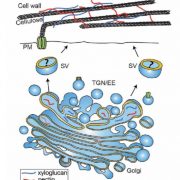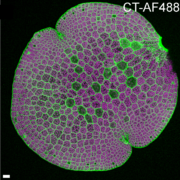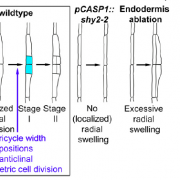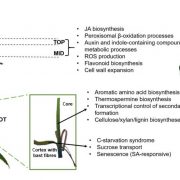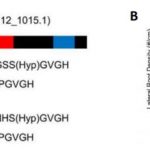FRA1 Kinesin Prevents Cell Wall Deposition from Going Off the Rails
Cellulose, hemicellulose, and pectin are the brick and mortar of the plant kingdom, and how they are laid has substantial impacts on plant morphology. Plant cell shape is dictated by the interplay between turgor pressure and heterogeneity in cell wall composition, whereby localized cell wall loosening or rigidifying causes enhanced or restricted cell expansion, respectively (Lampugnani et al., 2018).
Cortical microtubules (MTs) provide the scaffolding responsible for directing cellulose microfibril deposition by cellulose synthase complexes (CSCs). However, rapidly expanding tissues pose a serious problem: the necessity for more CSCs and the forces they generate can overwhelm the cortical MT scaffolds and result in improper cellulose deposition and aberrant plant morphology. Cellulose Synthase-Microtubule Uncoupling (CMU) proteins anchor cortical MTs to the plasma membrane to prevent scaffold breakage (Liu et al., 2016), but how CMUs are regulated remains an open question. Ganguly et al. (2020) report that MT motors modulate CMU levels in plant cells.

In addition to their role in guiding cellulose deposition by CSCs, cortical MTs also serve as tracks for motor proteins including the kinesin Fragile Fiber 1 (FRA1). FRA1 delivers vesicles containing pectin and other matrix polysaccharides to the extracellular space for deposition into the cell wall, and its absence results in brittle stems and dwarfism (Zhu et al., 2015). Yeast two-hybrid screens intended to identify FRA1 cargo instead revealed that the carboxy-terminal tail interacts with CMU1 and CMU2.
Genetic and phenotypic analyses in Arabidopsis thaliana showed that cmu1 cmu2 double mutant seedlings have skewed roots—a hallmark of MT orientation and cellulose deposition defects. Furthermore, cmu1 cmu2 exhibited genetic interactions that exacerbated the dwarfism and fertility defects in the fra1 background, indicating that FRA1 and CMUs are involved in a common cellular pathway.
One initial hypothesis was that CMUs regulate FRA1 motility; however, single-molecule tracking experiments showed that CMUs do not impact FRA1 motor activities. Rather, FRA1 differentially modulates CMU abundance by stabilizing CMU1 while suppressing CMU2 levels. CMU depletion in fra1 mutants leads to cortical MT drifting (Figure), consistent with CMU’s role as a cortical MT anchor. Remarkably, this finding provides an unusual instance where a motor can affect the properties of the track on which it moves. In the case of rapidly expanding tissues, increased FRA1 levels trigger CMU accumulation that stabilize the cortical MT network on which FRA1 travels.
How does FRA1 regulate CMU levels? Pharmacological experiments show that FRA1 protects CMU1 from proteasome-mediated degradation, although the precise mechanism is unknown. Genetic and biochemical experiments indicate that FRA1 phosphorylation—catalyzed by the microtubule-associated Casein Kinase1-Like 6—controls its interaction with CMUs. Thus, FRA1 phosphorylation could titrate CMU levels to reflect cellular needs and/or regulate the relative abundance of the CMU isoforms.
Many new questions emerge from this study. How does direct binding by FRA1 affect CMU localization and stability? What are the functional differences between the CMUs and how does FRA1 distinguish between them? Are other factors involved in this process? The answers will provide insight into how plants take shape.
Robert C. Augustine
Department of Biology
Vassar College
ORCID ID: 0000-0002-9614-1558
REFERENCES
Ganguly, A., Zhu, C., Chen, W., and Dixit, R. (2020). FRA1 kinesin modulates the lateral stability of cortical microtubules through Cellulose Synthase-Microtubule Uncoupling proteins. Plant Cell. DOI: https://doi.org/10.1105/tpc.19.00700
Lampugnani, E.R., Khan, G.A., Somssich, M., and Persson, S. (2018). Building a plant cell wall at a glance. J. Cell Sci. 131: jcs207373.
Liu, Z., Schneider, R., Kesten, C., Zhang, Y., Somssich, M., Zhang, Y., Fernie, A.R., and Persson, S. (2016). Cellulose-Microtubule Uncoupling proteins prevent lateral displacement of microtubules during cellulose synthesis in Arabidopsis. Dev. Cell 38: 305-315.
Zhu, C., Ganguly, A., Baskin, T.I., McClosky, D.D., Anderson, C.T., Foster, C., Meunier, K.A., Okamoto, R., Berg, H., and Dixit, R. (2015). The Fragile Fiber1 kinesin contributes to cortical microtubule-mediated trafficking of cell wall components. Plant Physiol. 167: 780-792.



